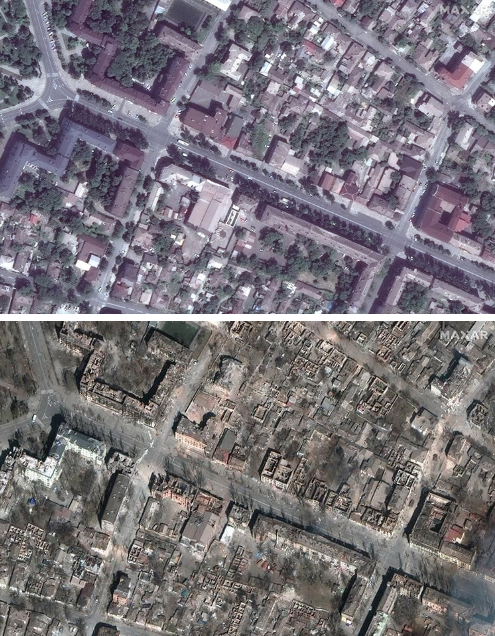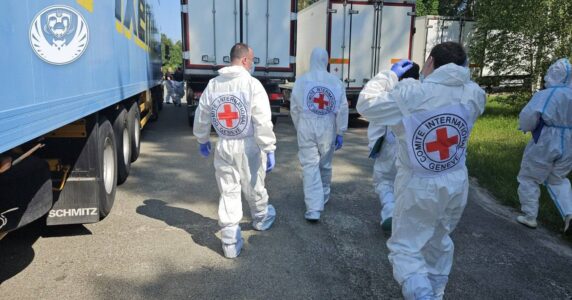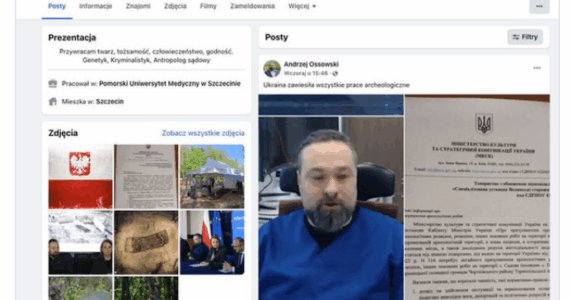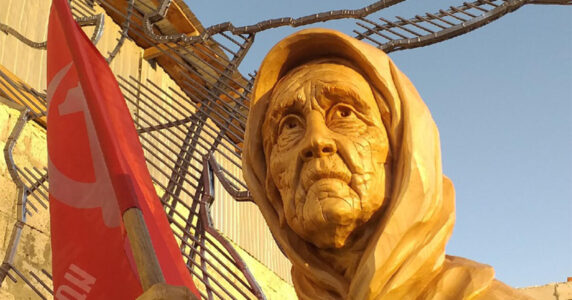Navigation and useful materials
Russia’s attack on Ukraine opened a new chapter in history. For the first time since Hitler’s quest for more space in Europe, one country seeks to fully destroy another. What’s more, Russians are openly fighting in full denial of the Ukrainian culture and with the purpose of ethnic assimilation of the conquered people.
Another feature of this war is that many civilians killed by Russia are Russian-speaking Ukrainians. Those same ones whom Putin alleged to be protecting from “genocide.”
The invasion was also not without real genocide. Currently, it is being documented in Bucha, liberated from the occupiers, and other parts of Kyiv, Chernihiv, and Sumy oblasts. Mariupol, Izium and Kherson are still there for us to find out more.
To cover it up, the Putin regime, which has recreated the Orwellian dystopia in its country, has launched a mode of unceasing shameless propaganda, in which war is peace, freedom is slavery, and ignorance is power.
The Centre for Strategic Communication has made a summary of key propaganda narratives of Russia which were promoted during the first six months of the full-scale Russo-Ukrainian war.
Russians Start and Lose
Russia was in for fatal defeats in the information space since the very start of Putin’s endeavour. What was supposed to be a blitzkrieg and the final “solution of the Ukrainian issue” turned into long months of shame for Moscow.
The United States, which warned of the attack, prepared the information field so that the world knew about Russia’s intentions to attack and closely observed its actions.
The Kremlin tried to create a formal pretext for war, casus belli. They arranged provocations — shelling of abandoned buildings on the Russian territory, the so-called “breakthrough of Ukrainian equipment,” the detonation of a car on the territory of “ORDLO,” theatrical evacuation of people from Donetsk which allegedly had to attest to shelling by Ukraine. However, it all looked rather absurd. At least for audiences outside of Russia.
For Putin, the invasion was an attempt to cut the Gordian knot of Ukraine, which he had been unable to untangle for years, starting with his Orange Revolution fiasco. The Washington Post writes that the Kremlin planned that only a strip of territory in the West was to remain with Ukraine.
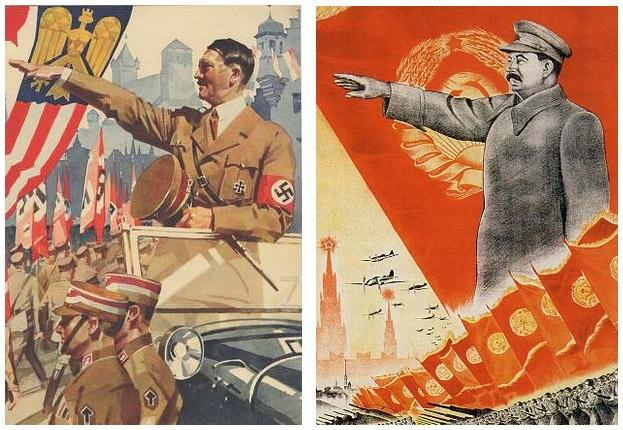
With such ambitious plans to win more “living space,” there was little point in looking for a believable casus belli, instead relying on the old and outdated principle of history being written by the victors.
Nazism Never Letting [Russians] Go
The declared goals of the war were highly pretentious and incomprehensible “denazification” and “demilitarization.” The absurdity of Putin’s regime’s claims to Ukraine with a president who made a career in Russian-language show business and overwhelmingly won the election doesn’t cease to amaze us. For their part, the Ukrainians surprised the invaders with national resistance. Eight years of hybrid war enabled the society to neutralize propaganda.
Resistance to the occupiers became the only possible course of action for people with a sense of justice. The determination of the Ukrainians influenced the readiness of the West to gradually start helping Ukraine on a serious scale.
Why did Putin accuse Zelenskyy of Nazism, despite the latter’s Jewish roots? We must keep in mind that the narrative about Ukrainians’ antisemitism and Nazism is an old record of Soviet propaganda. But despite all the senselessness of this narrative, Russia continues to promote it to both domestic and Western audiences even in 2022.
In an interview with the BBC, KGB researcher Liubomyr Lutsiuk said that the USSR consciously tried to sow discord between the Ukrainian and Jewish diaspora communities in North America in the 1970s. The Chekists even reported on the success of these operations. “Putin, a person from KGB in the Kremlin, speaks about the need to destroy ‘Banderovites’ in Ukraine, and later announces denazification. The West says it makes no sense, President Zelenskyy is of Jewish origin, what kind of Nazi can he possibly be?! And despite this, in the West, the idea of Ukrainians as Nazi collaborators is still present and still alive. This is where the real danger lies.”
Liubomyr Lutsiuk points out the danger that still exists today. According to him, there are people who a priori consider Ukrainians to be anti-Semites and Nazis. And some carriers of this sentiment, who have anti-Ukrainian bias and were engaged in the search of Nazis in North America, are now engaged in the investigation of Russians’ war crimes in Ukraine. According to Lutsiuk, the results of this investigation may be consciously anti-Ukrainian: “Indeed, Russians have committed horrible crimes, but Ukrainians have committed crimes, too. Perhaps the Russians are right that there are Nazis in Ukraine. This is the poison that the KGB spread in the West in the 70s, and they repeat and spread it to this day, again and again.”
It appears that the veterans of Soviet special services and their students did not reinvent the wheel, instead dusting off fifty-year-old guidebooks to undermine Ukrainians by means of labelling them as Nazi.
The same idea about Nazis was used for the internal audience as well. Russians are intimidated by shots of runic tattoos and parades of “Nazis” with torches. Media “brands” are created and designated to embody the ultimate evil. Based on their name alone, like it happened with Azov regiment, and previously — with the Right Sector.
Russians believe in Nazis and their crimes in Ukraine because people cannot comprehend how lies can continue for many years. In any case, their comforting thought is that there is no smoke without fire.
Apparently, even in the 21st century, it turned out possible to convince Russians to support the war with their neighbour by telling them propaganda-invented nonsense.
And all this despite the fact that the representatives of Putin’s regime occasionally admit their aggressive goals. 10 days before the start of the invasion, Vladislav Surkov, who had been the driver of the Kremlin’s expansionism for a long time, wrote an article in which he predicted: “And what’s next? Definitely not silence. A lot of geopolitics. Practical and applied. And even, perhaps, in contact. How can it be otherwise, if it is cramped and boring and uncomfortable… and it is unthinkable for Russia to remain within the limits of an insolent peace.”
“It’s cramped and boring and uncomfortable…” — this is the real motivation for the war for Russian society, which has lost its bearings in reality.
“Empire of Lies” during Hostilities
With the deployment of hostilities, Russian propaganda resorted to the “it’s not us” trick — mirroring all the accusations against themselves, putting forward similar but untrue accusations against Ukrainians. This is how “Ukrainian” destroyers of Ukrainian cities emerged on Russian TV, killers of Ukrainians, who hide behind civilians and carry out provocations at critical infrastructure facilities of Ukraine.
“Despite all our calls, the Nazis block thousands of Ukrainian citizens and many foreigners, preventing their evacuation to safe places,” claimed the head of the National Centre for Defence Management of Russia Mezentsev on March 4, preparing an information platform to disseminate disinformation in countries people from which were in Ukraine — mostly students.
While the occupiers attributed their own crimes to Ukrainians, imperialism was instead attributed to Ukraine’s Western partners. On March 16, Putin stated that “Trying to ‘cancel’ Russia, the West has torn off all masks of decency… The West’s ‘empire of lies’ is powerless against truth and justice, and Russia will continue to prove its position to the whole world.”
Moscow made sure to mention the hated Americans in its fantasies about biological and nuclear threats. “It became obvious that it is the American advisers who encourage and help the Kyiv regime in the creation of biological and nuclear weapons… We could not allow crazy, uncontrolled nationalists to have nuclear weapons,” said Patrushev, Secretary of the Security Council of the Russian Federation, on March 15.
Having painted an existential threat, they could now picture Russian occupiers as liberators, which head of Russia’s Foreign Intelligence Service, Naryshkin, tried to do on March 24: “Soldiers and officers of the Russian army are at the forefront of the fight against neo-Nazism fostered by Western totalitarian-liberal regimes.”
And at that time, the sinister reputation of these soldiers and officers needed constant whitewashing.
“The combat tactics, which were developed by the Ministry of Defence of Russia and our General Staff, fully justified themselves. And our guys, soldiers and officers show courage and heroism. They are doing everything they can to avoid losses among the civilian population of Ukrainian cities… Russia’s Armed Forces did not have the task to storm large cities,” the Russian dictator assured.
On the very day that Putin made this statement, the Russian army committed one of the bloodiest war crimes against civilians. Aviation bombed the Drama Theatre in Mariupol, resulting in deaths of 300 to 600 civilians, according to Mariupol City Council and an investigation by Associated Press, respectively.
As a result of the tragic storming of Mariupol, which was in full swing while Putin was lying about his concern for civilians, Russians killed up to 22,000 Mariupol residents, according to the estimates of Ukrainian authorities. And this is just one of many examples of distortion of reality, its distortion to the complete opposite.
The failure of the military operation and its information support in the first month did not change the Kremlin’s strategic course on the spread of disinformation in the world.
On March 23, at a meeting with students, the head of Russian diplomacy, Lavrov, said: “Ukraine is no longer being used to limit and, as much as possible, humiliate and destroy everything Russian. The entire world has already received the ‘take it!’ command […] they attack you just for having the Russian passport… This is the verdict for the Western civilization. I don’t know how they will whitewash themselves for history later.”
These words show that at the beginning of the full-scale war, the Putin regime was careful about losing its perceived reputation. It also felt that the “verdict” was coming not on the West, but on Russia itself. The visa ban, which Europe started discussing in August, clearly illustrates to Russians that their country has crossed all possible lines of civilized behaviour.
For Russians who still doubted the decision to attack Ukraine, the authorities came up with a pretext that Ukraine was going to attack first. “Russia’s special operation has thwarted the large-scale offensive of the Armed Forces of Ukraine on the LPR and DPR and helped to save thousands of civilian lives. The Armed Forces of the Russian Federation intercepted encrypted telegrams of the National Guard of Ukraine with a secret order to prepare an offensive on the Donbas by February 28,” the Russian Ministry of Defence said in a March 25 announcement. Russians liked this fake, since it allowed them to justify the aggression with noble considerations. Today, children in Russian schools are taught that Ukraine was preparing an attack on Russia, and Russia simply intercepted this attack.
After the failure in March, Russian military propagandists began to write about the need to focus on the goal of defeating the Ukrainian group in the East, and thus break the enemy’s resistance.
“Until the multi-thousand group of the ‘JFO’ is defeated, it is probably too early to speak about a march on Kharkiv, Odesa or Kyiv. Its destruction will give Russia both a tactical and a psychological advantage. It will inevitably undermine not only Ukraine’s defence capabilities, but also its fighting spirit, shattering the myth of Ukrainian propaganda about the invincibility of the ‘best army in Europe,’ wrote Alexander Kots, a military correspondent of the Russian occupiers, on March 29.
Thus, the first stage of the war was perceived by the Russian army as a failure, after which they had to rebuild confidence. However, as we all know, the Russians also failed to surround and defeat the Ukrainian army in the Donbas.
Defence against “Defenders”
One of the major propaganda narratives since the beginning of the war was, “the Nazis hide behind the backs of civilians and take them hostage, which leads to deaths among civilians.” Over time, propaganda began to promote this narrative with reference to human rights defenders who were concerned about the location of Ukrainian defenders at non-military infrastructure facilities.
As early as on March 29, the Russian government agency TASS referenced an article published in the Washington Post, which quoted humanitarian law expert Richard Weird from Human Rights Watch, saying that, “If there is military equipment there and [the Russians] are saying we are launching at this military equipment, it undermines an assertion that they are attacking intentionally civilian objects and civilians.”
Meanwhile, while storming cities, Russia did not ensure the principle of proportionality in accordance with the international humanitarian law, which says that, “Where the infliction of incidental harm on civilians or civilian objects cannot be avoided, it is subject to the principle of proportionality. Accordingly, those who plan or decide on an attack must refrain from launching, or must suspend, ‘any attack which may be expected to cause incidental loss of civilian life, injury to civilians, damage to civilian objects, or a combination thereof, which would be excessive in relation to the concrete and direct military advantage anticipated.’”
Later, a storm of criticism in Ukraine and abroad was raised by the press release of a study by Amnesty International (AI), which played along with the Kremlin’s narrative of the military hiding behind civilians. What was written essentially suggested that Ukrainians were themselves to blame for civilians’ deaths, because they were fighting in cities “in a wrong way.” Thus, knowingly or not, the report shifted the invaders’ moral responsibility and provoked further aggression.
The AI report was released a few days after the terrorist attack in Olenivka, which took place on the night of July 28-29, when the Russians killed captured Ukrainian soldiers from Mariupol, claiming that “Zelenskyy did it.” On the same day, a video of the torture and killing of a captured Ukrainian soldier was posted online, which was supposed to be a psychological blow in addition to the killing of Azov soldiers.
There were also noticeable attempts in the media to baselessly accuse Ukraine of careless treatment of weapons provided. Given that Russia has one of the most extensive networks of agents of influence since the USSR times, the tool of “independent experts” and journalists can bring about a real danger of malicious distortion of reality. Therefore, in the future, all attempts to justify the crimes of the aggressor, or to equate him with the victim, require careful attention, in particular, from civic investigators and security agencies.
Speaking to Ukrainian media on August 18, Mykhailo Podoliak, adviser to the head of the Office of the President of Ukraine, noted that the Russians have changed the tactics of the information war. “They are starting to work more subtly and cunningly and no longer push their narratives directly from themselves, through Sputnik and RT, as before. Today, they work with foreign journalists through various organizations. Therefore, if the war becomes prolonged, which is the course it is taking today, Russians will continue working in subtler ways. Their key task is to ensure a reputational crisis in Ukraine so that it is perceived as a state that cannot fulfil its obligations to reduce the flow of weapons that we are supposed to receive. They also want to influence the elites of Western countries so that their military industrial complex would not produce additional weapons.”
Thus, Ukrainian society and the international community are facing a situation when in the information field, the perpetrator can use propaganda to avoid not only legal but even moral responsibility, referring to the statements of “independent” experts.
Russia Sells Fear
Fear and intimidation are one of the Kremlin’s key tools. As early as in the address on February 24, Putin threatened the world: “those who try to stop us… must know that Russia’s response will be immediate and lead to consequences you have never experienced in your history before.”
A few days later, on March 4, Russia fired at the ZNPP, realizing that information about a possible accident at the nuclear plant would cause horror throughout the world. Meanwhile, Moscow felt it could play the role of “peacemaker” and “generously” help to resolve the problem it actually created.
Throughout the war, Russia’s MoD regularly amused Ukrainians with their absurdities, such as military stations in hospitals or kindergartens, the existence of “flying terrorists” who shell cities, or how the Security Service of Ukraine was preparing terrorist attacks in Odesa churches on Easter.
Here are some examples of how Kharkiv residents were intimidated. On March 7, Russia’s MoD claimed that “The Security Service of Ukraine, together with Azov Regiment militants, are preparing a provocation with possible radioactive contamination in the area of Kharkiv. Nationalists in Ukraine fused the reactor at the experimental nuclear facility at the Kharkiv Physical and Technical Institute.”
On March 30, Mizintsev stated that “militants of the Ukrainian national battalions have created ‘flying death squads’ that roam the streets of Kharkiv, intimidate citizens and conduct indiscriminate shooting from large-caliber machine guns at residential buildings… In Kharkiv hospitals, civilians are not provided with aid, and there is hardly any food left in shops… Immediate decisions aimed at stabilizing the humanitarian situation are needed to save the city’s residents.”
This intimidation was designed to undermine Ukrainians’ morale. Russian terrorism was also carried out by means of regular strikes and killings of civilians, particularly the ones in Vinnytsia, Kremenchuk, Kharkiv, Mykolaiv, etc.
Since the beginning of summer, the propaganda started threatening strikes on “decision-making centres.” At the same time, they doubled down on the statement that the AFU allegedly shelled Donetsk and the territory of Russia, which affect civilians. For example, they claimed that Ukraine was remotely scattering so-called “petal” landmines. The aggressor needed this narrative to twist the situation, portraying Ukraine as the aggressor instead.
In August, they added the story that Ukraine was allegedly preparing a terrorist attack on the ZNPP. The Kremlin occasionally scares the world with a nuclear disaster. It also brings up “hunger riots” in Western societies as a result of economic problems, which will allegedly cause the overthrow of the government. Back on March 28, Russia’s ambassador to the EU said that giving up Russian energy sources would be lethal for EU countries at this stage. He also alleged that the situation with the energy carriers could lead to government crises in certain European countries.
In August, according to OstWest, the Federal Service for the Protection of the Constitution (German domestic intelligence) said that in winter, Russia would probably try to use propaganda to polarize the German society and mobilize people to protests, arranging the so-called “winter of anger” in Germany. The agency said that Russian propaganda was trying to set up liaisons and boost its influence on the radical minority consisting of right-wing extremists, “Reich citizens” who believe that Germany is still occupied by the Allies, and supporters of other conspiracy theories. Russia also plans to organize mass protests, using such issues as the war in Ukraine, rising prices and the coronavirus pandemic for mobilization. Campaigners tied to Russia provoke fear of food and energy deficit and convince that the situation on the ground is so critical it puts the very existence of Germany in jeopardy. Information about the exposed plans of Putinism to attack Germany appeared against the background of an incident with aggressive booing of Chancellor Olaf Scholz at an open meeting with the Germans.
It can be assumed that Russia will try to use similar tools in other countries as part of its officially declared “war with the West.”
Researchers note that intimidation is part of terrorist strategy. It has direct and indirect victims. There is violence, but there is also the psychological effect of violence. The goal is not only to influence the immediate victim, but also to form the necessary behaviour patterns in the entire group, including witnesses, through information influence.
Thus, Russia’s informational terrorism is already affecting the whole world, forming the required patterns of behaviour.
The appropriate way to respond to blackmail and intimidation is not concession to the terrorists, which will lead to new and greater demands, leading to the defeat and destruction of the civilized world, but mobilization and a dignified counterattack.

Russian state media and the Kremlin’s statements should be perceived by global media not as media per se but as toxic carriers of the virus aimed to destroy the democratic world.
***
The Putinists believed that they could break the Ukrainian people, but every new day brings their campaign closer to defeat, and no lies are going to help with that.
If you have found a spelling error, please, notify us by selecting that text and pressing Ctrl+Enter.
